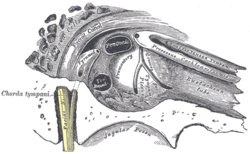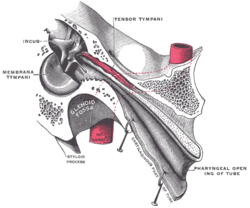Tensor tympani muscle
| Tensor tympani muscle | |
|---|---|
 The right membrana tympani with the hammer and the chorda tympani, viewed from within, from behind, and from above. | |
 The medial wall and part of the posterior and anterior walls of the right tympanic cavity, lateral view. (Label for "Tensor tympani muscle" is at right, second from bottom.) | |
| Details | |
| Origin | Auditory tube |
| Insertion | Handle of the malleus |
| Artery | Superior tympanic artery |
| Nerve | Medial pterygoid nerve from the mandibular nerve (V3) |
| Actions | Tensing the tympanic membrane |
| Identifiers | |
| Latin | Musculus tensor tympani |
| TA | A15.3.02.061 |
| FMA | 49028 |
The tensor tympani is a muscle within the ear. It is contained in the bony canal above the osseous portion of the auditory tube. Its role is to dampen sounds, such as those produced from chewing.
Structure

The tensor tympani arises from the cartilaginous portion of the auditory tube, and the adjoining part of the great wing of the sphenoid, as well as from the osseous canal in which it is contained. Passing backward through the canal, it ends in a slender tendon which enters the tympanic cavity, makes a sharp bend around the extremity of the septum, known as the processus cochleariformis, and is inserted into the neck of the malleus, near its root.[1]
The tensor tympani is the larger of the two muscles of the tympanic cavity, the other being the stapedius.
Innervation
Innervation of the tensor tympani is from the tensor tympani nerve, a branch of the mandibular division of the trigeminal nerve.[1] As the tensor tympani is innervated by motor fibers of the trigeminal nerve, it does not receive fibers from the trigeminal ganglion, which has sensory fibers only.
Development
The tensor tympani muscle develops from mesodermal tissue in the 1st pharyngeal arch.[2]
Function
The tensor tympani acts to dampen the noise produced by chewing. When tensed, the muscle pulls the malleus medially, tensing the tympanic membrane and damping vibration in the ear ossicles and thereby reducing the perceived amplitude of sounds.[1]
Voluntary control
Contracting muscles produce vibration and sound.[3] Slow twitch fibers produce 10 to 30 contractions per second (equivalent to 10 to 30 Hz sound frequency). Fast twitch fibers produce 30 to 70 contractions per second (equivalent to 30 to 70 Hz sound frequency).[4] The vibration can be witnessed and felt by highly tensing one's muscles, as when making a firm fist. The sound can be heard by pressing a highly tensed muscle against the ear, again a firm fist is a good example. The sound is usually described as a rumbling sound. A very small percentage of individuals can voluntarily produce this rumbling sound by contracting the tensor tympani muscle of the middle ear. The rumbling sound can also be heard when the neck or jaw muscles are highly tensed as when yawning deeply. This phenomenon has been known since (at least) 1884.[5]
Involuntary Control
Tympanic Reflex
The tympanic reflex helps prevent damage to the inner ear by muffling the transmission of vibrations from the tympanic membrane to the oval window. The reflex has a response time of 40 milliseconds, not fast enough to protect the ear from sudden loud noises such as an explosion or gunshot. Thus, the reflex most likely developed to protect early humans from loud thunder claps which do not happen in a split second.[6] The reflex works by contracting the muscles of the inner ear, the tensor tympani and the stapedius. This pulls the manubrium of the malleus inwards and tightens it. This tightening prevents the vibrations from disturbing the perilymph. Withdrawal from gabaA drugs like xanax had been known to cause tonic tensor tympani syndrome (TTTS) during withdrawal. The tympanic reflex will also activate when loud vibrations are generated by the person themselves - The tensor tympani can often be observed vibrating while shouting at an increased volume, dampening the sound somewhat.
Clinical significance
In many people with hyperacusis, an increased activity develops in the tensor tympani muscle in the middle ear as part of the startle response to some sounds. This lowered reflex threshold for tensor tympani contraction is activated by the perception/anticipation of loud sound, and is called tonic tensor tympani syndrome (TTTS). In some people with hyperacusis, the tensor tympani muscle can contract just by thinking about a loud sound. Following exposure to intolerable sounds, this contraction of the tensor tympani muscle tightens the ear drum, which can lead to the symptoms of ear pain/a fluttering sensation/a sensation of fullness in the ear (in the absence of any middle or inner ear pathology).
Additional images
 Base of skull. Inferior surface.
Base of skull. Inferior surface. External and middle ear, opened from the front. Right side.
External and middle ear, opened from the front. Right side. View of the inner wall of the tympanum (enlarged.)
View of the inner wall of the tympanum (enlarged.) Auditory tube, laid open by a cut in its long axis.
Auditory tube, laid open by a cut in its long axis.
See also
- Hearing
- Middle ear
- Ossicles
- Stapedius – the other major muscle in the middle ear
- Acoustic reflex
- Hyperacusis
References
This article incorporates text in the public domain from the 20th edition of Gray's Anatomy (1918)
- 1 2 3 Drake, Richard L.; Vogl, Wayne; Tibbitts, Adam; W.M. Mitchell (2005). Gray's anatomy for students. Illustrations by Richard; Richardson, Paul (Pbk. ed.). Philadelphia: Elsevier/Churchill Livingstone. pp. 862–3. ISBN 978-0-443-06612-2.
- ↑ Moore, Keith (2003). The Developing Human: Clinically Oriented Embryology (7th ed.). Philadelphia, Pennsylvania: Saunders. pp. 204–208. ISBN 0-7216-9412-8.
- ↑ Barry DT (1992). "Vibrations and sounds from evoked muscle twitches". Electromyography and Clinical Neurophysiology. 32 (1-2): 35–40. PMID 1541245.
- ↑ September 2009 - Welcome to racewalkingnewzealand.org, PROGRAM FITNESS NEWSLETTER September 2009 by Gary Little
- ↑ cf : Tillaux Paul Jules, Traité d’Anatomie topographique avec applications à la chirurgie, Paris Asselin et Houzeau publishers (4°ed. 1884, p. 125 )
- ↑ Saladin, Kenneth (2012). Anatomy and Physiology: The Unity of Form and Function (6th ed.). New York: McGraw-Hill. p. 601. ISBN 978-0-07-337825-1.